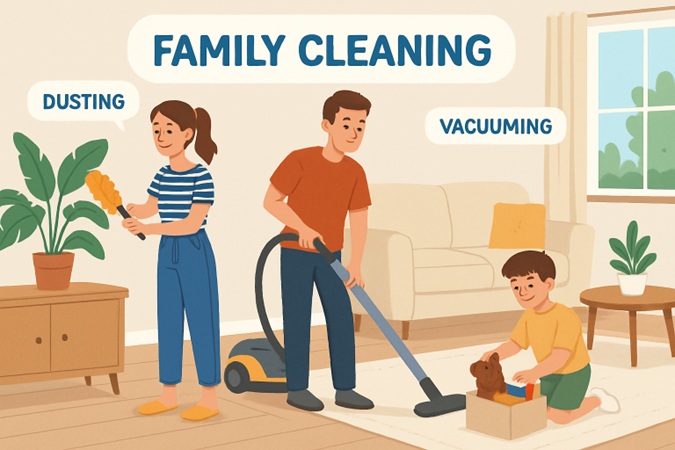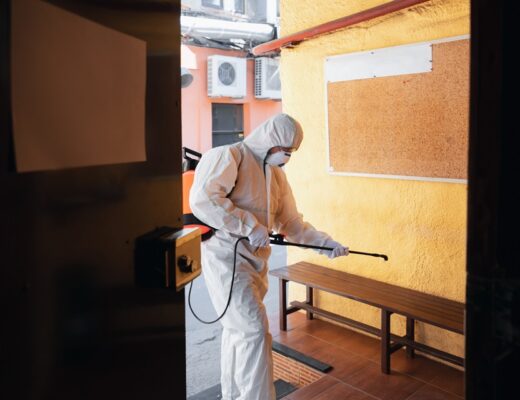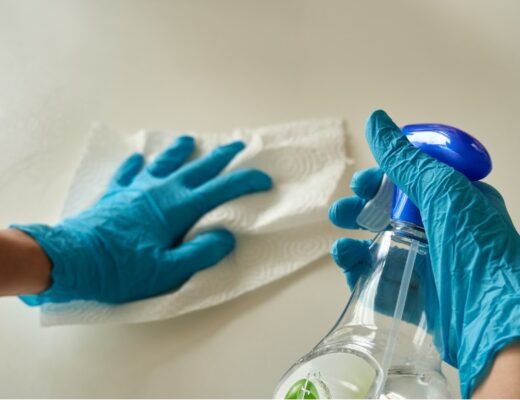Key Takeaways:
- Implement daily cleaning routines to prevent dirt accumulation.
- Choose non-toxic, eco-friendly cleaning products to safeguard health.
- Enhance indoor air quality through proper ventilation and air-purifying plants.
- Regularly declutter to minimize dust and allergens.
- Involve all household members in maintaining cleanliness.
Creating a clean, healthy home can feel overwhelming, but small, consistent habits make all the difference. Building straightforward routines and making mindful choices about products and cleaning processes lead to a home that fosters your family’s well-being. Whether you handle household chores or opt for professional residential cleaning services, integrating practical techniques can transform your living space into a sanctuary of cleanliness and health.
Clean environments do more than look good—they support physical and mental health by reducing allergens, contaminants, and clutter-induced stress. Focusing on daily maintenance, using safer products, and getting everyone on board with tasks are transformative habits easily adopted over time.
Table of Contents
Establish A Daily Cleaning Routine
Consistency is the cornerstone of a perpetually tidy home. Spending even 10–15 minutes daily on essential chores—making the bed, wiping kitchen counters, sweeping frequently used spaces—prevents dirt and messes from accumulating. Routine actions shrink the mountain of cleaning into manageable molehills and foster a sense of accomplishment in everyday life. For families, setting a daily cleaning time helps everyone develop good habits. Simple habits like putting away shoes, clearing dishes, and folding laundry keep your environment spotless and instill a sense of responsibility in all members. Approaching routines as shared activities can make the process more effective and enjoyable.

Opt For Non-Toxic Cleaning Products
Switching to non-toxic, eco-friendly cleaning products like vinegar, baking soda, and lemon juice can improve indoor air quality and health, especially for children and pets. Essential oils like tea tree, lavender, and eucalyptus can add fresh scents and antibacterial properties to homemade sprays. Selecting cleaning products with certified green brands and checking ingredient lists ensures toxins are avoided, benefiting respiratory health and reducing environmental impact.
If you’re responsible for larger spaces or work environments, utilizing a trusted commercial cleaning service ensures hygiene on a broader scale and keeps work areas healthy for employees and clients alike. These professionals often use industrial-grade, eco-conscious products that meet health and safety standards. Regular deep cleaning minimizes allergens and germs and promotes a more productive and welcoming atmosphere. Investing in sustainable cleaning practices across all environments supports long-term well-being and environmental responsibility.
Enhance Indoor Air Quality
Airborne allergens, dust, and pollutants can silently accumulate indoors, affecting health through respiratory irritation and unexplained fatigue or headaches. Improving ventilation—by opening windows regularly, using exhaust fans in kitchens and bathrooms, and placing air purifiers with HEPA filters in main rooms—substantially affects air quality. According to the Environmental Protection Agency, indoor air can be up to five times more polluted than outdoor air, underscoring the importance of maintenance. Adding houseplants like spider plants, peace lilies, and snake plants boosts air purification naturally. These plants filter out common toxins, add beauty, and may even improve mood. Remember to change HVAC filters at least every three months to maximize home filtration and comfort year-round.
Declutter Regularly
Clutter creates a visually chaotic environment and harbors dust, pollen, and other allergens that can exacerbate allergies and asthma. Set aside time monthly to assess possessions—donate clothes, toys, and household goods no longer needed. A streamlined home is easier to clean, reduces stress, and creates a more functional living space.
Embracing minimalism doesn’t mean going without essentials, but keeping only what is useful brings joy. Decluttering can become a family effort or a mindful, solo activity that offers clarity and a fresh perspective. Studies have shown that reduced clutter is linked to lower cortisol (stress hormone) levels and a greater well-being.
Focus On High-Touch Surfaces
Regularly disinfecting high-touch areas—such as doorknobs, light switches, faucet handles, and remote controls—protects your household from the spread of bacteria and viruses. Aim to sanitize these zones at least once a week, or more frequently during cold and flu seasons. Use a simple homemade disinfectant (like alcohol or a diluted bleach solution) or pre-moistened wipes for convenience. Always follow the manufacturer’s directions to avoid damaging sensitive surfaces or electronics.
Involve The Whole Household
Maintaining a healthy environment is easier and more consistent when all household members participate. Assign age-appropriate chores so each person has a role—young children can help pick up toys and wipe down surfaces, while older children and adults can handle vacuuming, mopping, or laundry.
For workplaces, relying on professional office cleaning and maintenance services helps ensure that cleanliness standards are upheld consistently, creating a healthier and more organized environment for employees and visitors alike.
Use Proper Cleaning Tools
Investing in reliable, practical cleaning tools improves efficiency and provides better results. Microfiber cloths excel at trapping dust and dirt, reducing the need for excessive chemicals. A vacuum equipped with a HEPA filter ensures that allergens are captured rather than recirculated. Additionally, having specific brushes or mops for various tasks minimizes cross-contamination. Please also pay attention to tool care: regularly washing mops, microfiber cloths, and vacuum filters maintains their effectiveness and longevity. These best practices keep your cleaning arsenal ready for action.
Maintain Kitchen & Bathroom Hygiene
The kitchen and bathroom require extra vigilance due to moisture, food residue, and frequent use, which make these spaces hotspots for germs. In the kitchen, wipe down counters promptly after food prep, clean sinks to prevent grime, and regularly disinfect handles on appliances. Store food properly to avoid attracting pests, and keep trash cans clean and sealed. Bathrooms demand weekly disinfecting of showers, toilets, and sinks. Launder bathmats and towels often, and remember to clean the area around drains and faucets, where bacteria love to congregate. These habits keep mold and bacteria in check and promote lasting hygiene. Adopting these simple strategies for daily maintenance, product choices, air quality, and household involvement transforms your home into a space that truly nurtures health and happiness for everyone there.







No Comments